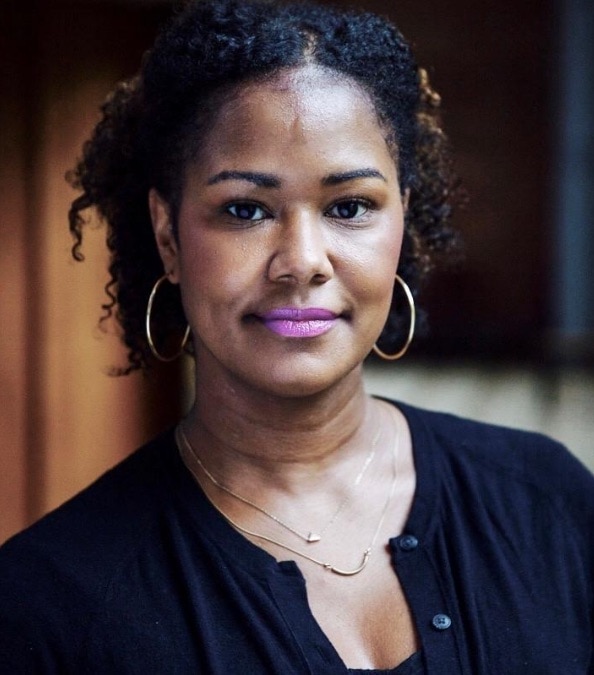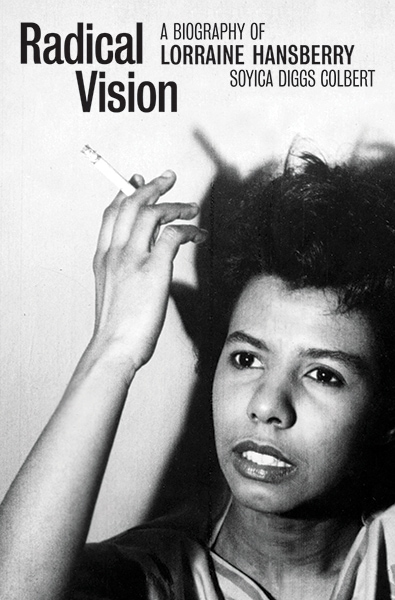Although Shakespeare Theatre Company’s acclaimed The Amen Corner had to shut down in March before its run was done, the production proved fortuitous for STC’s future: It brought Director Whitney White and Dramaturg Soyica Colbert into a working relationship that led in August to Artistic Director Simon Godwin’s announcement that White and Colbert would be associate directors of the company. Recently Michele Simms-Burton—who shares with Colbert a deep background in African American dramatic literature—interviewed Colbert by Zoom. They talked about what a Black theatrical canon could look like, why diversifying leadership matters, August Wilson’s legacy for Black playwrights, and why a racist theater cannot survive.

Michele Simms-Burton: First of all, congratulations on your appointment as associate director of STC. We’re very proud of you in the community.
Soyica Colbert: Well, thank you. I’m going to do my best.
Thinking ahead to this conversation made me rethink our entire history in American theater, as Black playwrights and Black performers. How do we figure into the broad tapestry of American theater? So often we encounter lack of inclusivity. Now that STC has brought both you and Whitney on board, how do you envision your role in opening up theater to be more inclusive?
I started a conversation with Simon Godwin, the artistic director, over a year ago. At the time I was chair of the department of performing arts at Georgetown. He reached out to me because he was new to the DC theater scene and wanted to make connections with other folks working in theater. He expressed a deep commitment to diversify the community at STC, building new audiences, reaching out to the diversity that is Washington, DC, and wanting to be thought partners in that exploration.

That set of conversations laid the groundwork for my participation in Amen Corner. And after that really positive experience, the theater invited me to be in this role as associate director. I appreciated that we had already established a relationship and he had expressed his vision and his investment before I was asked to come on board in this capacity. I also appreciated that the theater made a significant financial investment in Amen Corner, not only in terms of the actors, the public-facing part of the production, but also behind the scenes, the folks that Whitney brought on. The theater was willing to do that.
One of the main challenges in theater is that even if companies produce Black plays, the directors and the designers are often not people color, and that was not the case in this production. That also suggested to me that they were willing to do the work that was necessary to have a transformative piece of art.
In terms of moving forward, I hope to work with them collaboratively to continue that type of work. With Amen Corner, there was a lot of wraparound programming. They engaged with Howard, they engaged with Smithsonian, sites that are more historically Black spaces in this city where STC is not. Understanding the need for collaboration suggested to me they were willing to do the work.
Often when we often talk about canon, it’s more exclusive than inclusive, and when we talk about classical, it’s European-based and also more exclusive than inclusive. How do you see identifying or distinguishing what a Black canon in theater would look like? And what would Black classical plays look like within the context of STC?
One of the things that STC is trying to do is to reengage with the history of Black theater and some plays that have not been produced very often from earlier time periods—plays like Amen Corner, like some of Lorraine Hansberry’s work besides Raisin—engaging with plays from the mid century and earlier that have been overlooked because of the context of their times but are right for production now. Amen Corner is a good example of that. The National Theatre’s production of Hansberry’s Les Blancs is a good example of that. Alice Childress’s work is a good example of that. All of these could be part of the American canon, but because of the history of American theater and race relations in the mid century, these plays did not have their truest production history. Alice Childress explicitly meditates on this in her work. I think STC is looking not to rediscover these plays—because they’re hiding in plain sight—but to invest resources to produce them in a time when audiences are ready for them. The plays are ready. They’re sitting there waiting to be produced. But they haven’t been understood as central because they never had that production that gave them their full glory. So much of how we understand the history of the canon is related to when and how plays are produced.
If you could stage one play right now with all the support that you needed, which one would you choose?

I’m biased because I’m finishing a book on Hansberry.
I know you are!
So I have a predisposition. I think that the production of Les Blancs at the National Theatre was amazing. I thought the production in Chicago of The Sign in Sidney Brewstein’s Window—which was not one of my favorite Hansberry plays but now I love it—was amazing. Either one of those produced in DC would be transformative. But honestly I think that Alice Childress’s Trouble in Mind is waiting for a great regional theater production and would be powerful in DC and could be produced in really profound ways.
I like that.
I also think that there’s lots of experimental drama that is more contemporary that would be really exciting for DC audiences. This is part of what captivated audiences around Jackie Sibblies Drury’s Fairview in New York. Certainly some of Suzan-Lori Parks’s earlier drama that’s more experimental could have a new life in DC. Although she’s becoming more well-known for plays that hew more closely to realism, some of her earlier experimental work is really powerful and could animate audiences at this time.
How does STC see itself in terms of sustaining future playwrights, particularly Black playwrights and nonbinary playwrights? Or is that even on the table?
In his first season as artistic director, Simon produced Branden Jacobs-Jenkins’s Everybody—which was classical theater, an adaptation of Everyman—and the director was a nonbinary person. They also produced Amen Corner by James Baldwin with a Black woman director. Within his first season, there was this shift from what STC had been doing historically. Being true to the mission of the theater while at the same time attending to diversity—both in contemporary playwrights, as well as historically in a longer history—is I think what the theater is trying to do. For Branden Jacobs-Jenkins, who I think of as a master of form, his work is right for consideration in the context of what STC is trying to do, just because so much of his work is a comment on what we understand as classical theater.
What is your vision of an anti-racist theater?
The work that happens in a theater is related to the economies that underpin it, and so I think that a truly anti-racist theater would have to be a public theater in some capacity. The arts in the United States were always contending with racism being embedded in capitalism. Until we have a public theater, a publicly funded arts, then it’ll be much more difficult for us to have an anti-racist theater or art scene more generally in the U.S.
I’ve been buoyed a little bit with foundations’ recent responses for supporting Black arts and arts by people of color—primarily in response to the devastation of COVID but also in response to a longer history of exclusion. The Ford Foundation recently pledged a major gift to support art by people of color, specifically in theater. The Mellon Foundation has The Black Seed project to support theaters of color. Both those gifts are tied to the leadership of the Ford Foundation and the Mellon Foundation. As we diversify leadership in our foundations and our theaters, more spaces open up to reconsider the work that’s being done and support visions for more diversity within the theaters themselves. While obviously foundation support is not the same thing as public funding, those commitments by foundations will help to respond to what has been a long conversation in Black theater—thinking about August Wilson’s “The Ground on Which I Stand” and how regional theaters might be theaters for the publics they’re supposed to serve.
The last piece I’ll say is, there’s great excitement about regional theater’s newly appointed directors and diversifying of their staff. When we think about who’s leading regional theaters, how regional theaters have served as places to develop playwrights, and how a vision of more inclusivity and equity might be furthered by diversity at the top of these institutions, that also shows a possibility for anti-racist work.
Where do you think U.S. theater will be 10 years from now vis-à-vis race and racism?
I think U.S. theater will have to be less racist just because if it wants to survive, it will need to be. Who are the audiences, right? As America becomes more diverse demographically, the theater has to respond to who audiences are, what are the demographics of our cities where a lot of regional theaters are, and how to be in conversation with those communities. The best work of regional theaters is really having the pulse of what is happening at the community level and engaging audiences in that work. To the extent that theaters will survive, it will be required that they continue to engage and think about new audiences and how we might understand audience in that capacity. That’s why I think it’s exciting to imagine models that are collaborative with other institutions that reach out to the community. And obviously what community means is regionally specific. In Washington, we still say DC the Mocca City, international city; it has lots of rich histories of Black folks, people of color. All of those aspects in the DC theater scene are important as you think about audience.
Is there anything you want to add?
It’s exciting to see what I call the after-August generation: playwrights that came after August Wilson who have already transformed the theater by people of color we see in the U.S. His work was a watershed, because it demonstrated the saleability of Black theater on Broadway. If that is the gold standard for producibility (and I don’t necessarily think it should be), August Wilson opened a door. So many playwrights have walked through that door and not done so in a replicative way but have created their own lanes.
Lynn Nottage and Tarell Alvin McCraney both are working at universities and helping to cultivate new generations of playwrights after them. Even within Lynn Nottage’s own canon there is diversity, which is part of her brilliance. Just think about Branden Jacobs-Jenkins alongside of Katori Hall, both brilliant and working in different mediums—theater, film, television. All of those different possibilities can be attributed to the doors August Wilson opened. They give us models for even more proliferation. In this moment, it’s great that we have so many content creators, because now the institutional doors are being opened more widely as well.
About Soyica Colbert:
Dr. Soyica Colbert, the Vice Dean of Faculty and Idol Family Professor of the College of Arts and Sciences at Georgetown University, has advised Arena Stage as a dramaturg for their productions of A Raisin in the Sun and Two Trains Running. Having received prestigious fellowships for the National Endowment for the Humanities, Mellon, and Woodrow Wilson, Colbert is the author of The African American Theatrical Body: Reception, Performance and the Stage and Black Movements: Performance and Cultural Politics. She edited the Black Performance special issue of African American Review and co-edited The Psychic Hold of Slavery. The co-edited Race and Performance After Repetition was published in September and a monograph Becoming Free: An Intellectual Biography of Lorraine Hansberry is forthcoming in 2021.
RELATED:
Shakespeare Theatre Company rescues James Baldwin’s ‘Amen Corner’ from the vault by Michele Simms-Burton
Whitney White on directing James Baldwin’s classic ‘The Amen Corner’ at Shakespeare Theatre Company by John Stoltenberg
Whitney White and Soyica Colbert join Shakespeare Theatre Company




